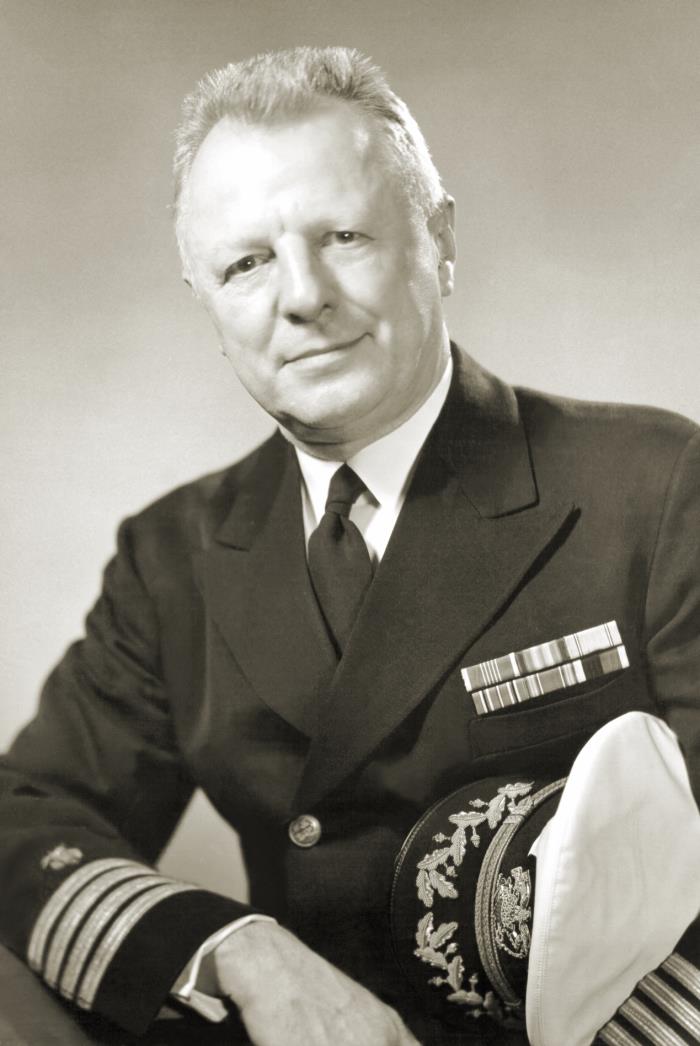April 14, 2023
Dr. H. Trendley Dean: Utilizing the Hidden Powers of Fluoride

Dr. H. Trendley Dean’s attention was captured after hearing of the discolored teeth in Colorado Springs, known as the “Colorado Brown Stain.”1 Despite the lacking aesthetics of these teeth, the people with these stains benefited from a higher resistance to cavities or caries. This perplexing mystery was not unraveled until many years later when it was reported that the condition was due to high levels of fluoride in the water. This answer only led to more unanswered questions. Could fluoride be the key to caries prevention? In 1931, Dr. Dean set out to discover more about fluoride’s hidden powers.2

Dr. H. Trendley Dean was born on August 25, 1893, in Winstanley Park, Illinois, and in 1916 received his Doctorate of Dental Surgery (D.D.S.) at St. Louis University.3 He practiced privately before joining the military and later became part of the United States Public Health Service. In 1931, he joined the National Institute of Health (NIH) as its first dental scientist to study mottled enamel, and became the head of the Dental Hygiene Unit.4
Interest in the staining of teeth began in 1901, with Dr. Frederick S. McKay. He started practicing in Colorado Springs and quickly noticed the stained enamel, or outer layer, of his patients’ teeth. He went to the El Paso County Odontological Society to have the condition investigated, and many years later, in 1908, Drs. McKay, Fleming, and Burton, permitted by the now Colorado Springs Dental Society, studied mottled enamel in public school children.5 They found that 87.5% of the 2,945 students were affected by the staining, and they were all native to the Colorado Springs area.6 To find the cause, Dr. McKay continued to study the conditio. He suspected that there must be something in the water causing the staining. He reported the presence of the mottled enamel in Bauxite, Arkansas, a town owned by the Aluminum Company of America (ALCOA).7 After his report, the chief chemist of ALCOA, Dr. H.V. Churchill, began studying the water in Bauxite. His results revealed the answer to Dr. McKay’s three-decade-long search. The water contained large amounts of fluoride, the ion of fluorine.
Shortly after the discovery of fluoride in the water of communities like Bauxite, Dr. Henry Trendley Dean continued the research on fluoride. “Fluorosis” was the term he adopted for the “mottled enamel” condition caused by fluoride. He created the Fluorosis Index to classify the severity of fluorosis from very mild to severe.8 The very mild form of fluorosis has light-white areas of discoloration that cover less than 25% of the tooth surfaces.9 Mild has light white areas, and moderate can include light brown areas of discoloration. Mild covers less than 50% and moderate covers over 50%. All surfaces are affected in the severe classification and can have white, light brown, or dark brown spots and pitting.10 Pitting describes depressions in the enamel of the tooth. After studying the effects of the condition, Dr. Dean turned to its cause. As his research began, he wanted to find the level of fluoride in the water that would cause the mildest form of fluorosis.

An accurate way to measure fluoride was needed in order to identify the levels of fluoride in the water supplies of different cities to record the prevalence of fluorosis. It was also necessary so that fluoride levels could be manipulated. Dr. Elias Elvove was a senior chemist at the NIH and began developing a technique to do so at Dr. Dean’s request. Dr. Elvove’s technique for measuring fluoride in water was down to an accuracy of 0.1 ppm (parts per million).11 Using this technique, Dr. Dean determined fluoride levels over 1 ppm could cause fluorosis.12 Now that fluoride levels could be measured accurately, he set out to determine if fluoride could lower the cavity rate.
In previous research, it had been observed that areas with a high prevalence of fluorosis had lower cavity rates. Tooth decay, or dental caries, has been a common disease that dentists like Dr. Dean were used to treating. Preventing dental caries had not been truly explored before, but it was something Dr. Dean wanted to try. With fluoride now on the scene, it could play a key role in caries prevention. In 1945, he began a large-scale study in Grand Rapids, Michigan that lasted for fifteen years.13 Low amounts of fluoride were added to the city’s water supply, and the results showed that oral health in children attending public school had improved. Dental caries had been reduced by 50% to over 60%.14
Other cities were also studied to see if the fluoride in the water would prove to be effective in caries prevention. These studies were similar to the Grand Rapids, Michigan study. In New York, water was fluoridated in the city of Newburgh, and caries prevalence was compared to Kingston, New York. Kingston acted as the control of the experiment and had not been fluoridated. The same was done in Evanston, Illinois with Oak Park, Illinois as its control. Internationally, studies were also done in countries like Canada, New Zealand, the Netherlands, and the United Kingdom.15 Results were found to be consistent with the Grand Rapids study.
Researchers spent many years gathering evidence that supported the finding that fluoride would be the key to caries prevention. Over the years, many studies have been found to be effective in proving that the addition of fluoride, or fluoridation, to the public’s water supply, is successful in preventing caries. After presenting the gathered information, their hard work, especially with Dr. Dean, began to pay off. In 1950, the American Dental Association (ADA) endorsed the fluoridation of public water supplies.16 The studies showed that “people living in communities with fluoridated water had fewer cavities and healthier teeth than those living in communities where the water was not fluoridated.”17 The improvement of oral health due to fluoridation led the United States Public Health Service to recommend community water fluoridation.18 The recommendation became effective on April 5, 1962. Many cities began to follow the recommendation, and the community water supplies now had low concentrations of fluoride ranging from 0.7 mg/L (milligrams per liter) to 1.2 mg/L.19 These low concentrations were deemed safe for consumption and would no longer increase the risk of fluorosis.

Oral health could now be improved across the United States regardless of one’s socioeconomic background. This was thanks to the contributions of many people, especially Dr. H. Trendley Dean. In 1948, Congress established the National Institute of Dental Research and appointed Dr. Dean as the director.20 He retired in 1953 and was able to see the start of the implementation of fluoridation in cities before his death on May 13, 1962.
It is now known that fluorosis can only develop in children younger than eight because their permanent teeth are still developing within the gums.21 Today, there are multiple products containing fluoride to aid in cavity prevention. To further decrease the risk of fluorosis, the recommended concentration was lowered. More access to fluoride has the potential to increase fluorosis cases. The recommended concentration of fluoride in water was changed to 0.7 mg/L.22 Although it is not required for cities, fluoridation is now a commonly practiced preventative healthcare measure across the United States.
- James H. Pearce, Jr., D.D.S., “A Colorado Story,” Colorado Dental Association (website) (October 8, 2015): 11, https://cdaonline.org/news/latest-news/a-colorado-story/. ↵
- “Achievements in Public Health, 1900-1999: Fluoridation of Drinking Water to Prevent Dental Caries,” JAMA 283, no. 10 (March 8, 2000): 1284, https://doi.org/10.1001/jama.283.10.1283. ↵
- Special to The New York Times., “H.Trendley Dean, Dental Scientist: Early Investigator of Effect of Fluoridated Water Dies Studied Discolored Teeth,” New York Times, May 15, 1962. ↵
- “Achievements in Public Health, 1900-1999: Fluoridation of Drinking Water to Prevent Dental Caries,” JAMA 283, no. 10 (March 8, 2000): 1284, https://doi.org/10.1001/jama.283.10.1283. ↵
- James H. Pearce, Jr., D.D.S., “A Colorado Story,” Colorado Dental Association (website), (October 8, 2015): 11, https://cdaonline.org/news/latest-news/a-colorado-story/. ↵
- James H. Pearce, Jr., D.D.S., “A Colorado Story,” Colorado Dental Association (website), (October 8, 2015): 11, https://cdaonline.org/news/latest-news/a-colorado-story/. ↵
- James H. Pearce, Jr., D.D.S., “A Colorado Story,” Colorado Dental Association (October 8, 2015): 11, https://cdaonline.org/news/latest-news/a-colorado-story/. ↵
- “Achievements in Public Health, 1900-1999: Fluoridation of Drinking Water to Prevent Dental Caries,” JAMA 283, no. 10 (March 8, 2000): 1283, https://doi.org/10.1001/jama.283.10.1283. ↵
- “Fluorosis: What It Is, Causes & Treatment,” Cleveland Clinic (website), June 8, 2022, https://my.clevelandclinic.org/health/diseases/23227-fluorosis. ↵
- “Fluorosis: What It Is, Causes & Treatment,” Cleveland Clinic (website), June 8, 2022, https://my.clevelandclinic.org/health/diseases/23227-fluorosis. ↵
- “Achievements in Public Health, 1900-1999: Fluoridation of Drinking Water to Prevent Dental Caries,” JAMA 283, no. 10 (March 8, 2000): 1284, https://doi.org/10.1001/jama.283.10.1283. ↵
- James H. Pearce, Jr., D.D.S., “A Colorado Story,” Colorado Dental Association (website), (October 8, 2015): 11, https://cdaonline.org/news/latest-news/a-colorado-story/. ↵
- James H. Pearce, Jr., D.D.S., “A Colorado Story,” Colorado Dental Association (website), (October 8, 2015): 11, https://cdaonline.org/news/latest-news/a-colorado-story/. ↵
- James H. Pearce, Jr., D.D.S., “A Colorado Story,” Colorado Dental Association (website), (October 8, 2015): 11, https://cdaonline.org/news/latest-news/a-colorado-story/. ↵
- James H. Pearce, Jr., D.D.S., “A Colorado Story,” Colorado Dental Association (website), (October 8, 2015): 11, https://cdaonline.org/news/latest-news/a-colorado-story/. ↵
- Fluoridation Facts (American Dental Association, 2018), 5 https://ebooks.ada.org/fluoridationfacts/?_ga=2.166967805.231521014.1676381357-271099935.1676381357. ↵
- Vivek H. Murthy, “Community Water Fluoridation: One of CDC’s ‘10 Great Public Health Achievements of the 20th Century,’” Public Health Reports (July 1, 2015): 296, https://doi.org/10.1177/003335491513000402. ↵
- Vivek H. Murthy, “Community Water Fluoridation: One of CDC’s ‘10 Great Public Health Achievements of the 20th Century,’” Public Health Reports (July 1, 2015): 296, https://doi.org/10.1177/003335491513000402. ↵
- U. S. Department of Health and Human Services Federal Panel on Community Water Fluoridation, “U.S. Public Health Service Recommendation for Fluoride Concentration in Drinking Water for the Prevention of Dental Caries,” Public Health Reports 130, no. 4 (August 2015): 318, https://doi.org/10.1177/003335491513000408. ↵
- Special to The New York Times., “H.Trendley Dean, Dental Scientist: Early Investigator of Effect of Fluoridated Water Dies Studied Discolored Teeth,” New York Times, May 15, 1962. ↵
- Vivek H. Murthy, “Community Water Fluoridation: One of CDC’s ‘10 Great Public Health Achievements of the 20th Century,’” Public Health Reports (July 1, 2015): 296, https://doi.org/10.1177/003335491513000402. ↵
- U. S. Department of Health and Human Services Federal Panel on Community Water Fluoridation, “U.S. Public Health Service Recommendation for Fluoride Concentration in Drinking Water for the Prevention of Dental Caries,” Public Health Reports 130, no. 4 (August 2015): 319, https://doi.org/10.1177/003335491513000408. ↵
Tags from the story
Dr. H. Trendley Dean
fluoridation
fluoride
fluorosis
mottled enamel
Nomination-Science
Recent Comments
Carlos Alonzo
This was an impressive article full of the facts related to the powers of fluoride on public health. Dr. H. Trendley Dean’s work revolutionized the ability to prevent tooth decay which led to improvements in dental care worldwide. I cannot believe the impact and I wonder how dentists felt when something that was a service of theirs was undermined. Dr. Dean’s contributions continues to improve the oral healthcare practices of dentists and the communities public health.
11/05/2023
7:31 am
Hailey Koch
Great job on your article, you chose a very interesting topic. I absolutely love to use things that make my teeth appear whiter. I had no idea it was even possible to put fluoride in water supply let alone that this is something that has already been done. It’s incredible that the children that had attended public schools where fluoride was in the water supply had an increase in positive oral health. Congrats on the nomination for your article it was very informative and educated me on a subject I didn’t know much about.
27/04/2023
7:31 am